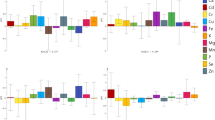Abstract
In this study, concentrations of heavy metals (Cd, Cr, Cu, Pb, and Zn) were determined in three edible mushroom species (Lactarius deliciosus, Russula delica, and Rhizopogon roseolus) collected in five sampling sites in Canakkale province, Turkey. Mean values of Cd, Cr, Cu, Pb, and Zn were 0.72, 0.26, 28.34, 1.53, and 64.62 mg/kg, respectively. The highest concentrations of Cd, Cu, Pb, and Zn were determined in species R. delica, while Cr was observed in L. deliciosus. In terms of the nutritional aspect, taking into account the concentration of Provisional Tolerable Weekly Intake recommended by FAO/WHO, the maximum concentration of Cd is a restrictive factor for consumption of the collected mushroom species. The concentrations of the other elements have no health risks when consumed at optimal levels.

Similar content being viewed by others
References
Baeza A, Hernandez S, Guillen FJ et al (2004) Radiocesium and natural gamma emitters in mushrooms collected in Spain. Sci Total Environ 318:59–71
Barnett CL, Beresford NA, Self PL et al (1999) Radiocaesium activity concentrations in the fruit-bodies of macrofungi in Great Britain and an assessment of dietary intake habit. Sci Total Environ 231:67–83
Cocchi L, Vescovi L, Petrini LE et al (2006) Heavy metals in edible mushrooms in Italy. Food Chem 98:277–284
Kalac P, Svoboda L (1998) Heavy metals in edible mushrooms. Czech J Food Sci 16:110–116
Svoboda L, Zimmermannova K, Kalac P (2000) Concentration of mercury, cadmium, lead and copper in fruiting bodies of edible mushrooms in an emission area of a copper smelter and a mercury smelter. Sci Total Environ 246:61–67
Demirbas A (2001) Heavy metal bioaccumulation by mushrooms from artificially fortified soils. Food Chem 74:293–301
Isildak O, Turkekul I, Elmastas M et al (2004) Analysis of heavy metals in some wild grown edible mushrooms from the middle black sea region, Turkey. Food Chem 86:547–552
Soylak M, Saraçoğlu S, Tüzen M et al (2005) Determination of trace metals in mushroom samples from Kayseri, Turkey. Food Chem 92:649–652
Turkekul I, Elmastas M, Tüzen M (2004) Determination of iron, copper, manganese, zinc, lead, and cadmium in mushroom samples from Tokat, Turkey. Food Chem 84:389–392
Tüzen M (2003) Determination of heavy metals in soil, mushroom and plant samples by atomic absorptions spectrometry. Microchem J 74:289–297
Yamac M, Yıldız D, Sarıkürkcü C et al (2007) Heavy metals in some edible mushrooms from the Central Anatolia, Turkey. Food Chem 103:263–267
Mendil D, Uluözlü OD, Tüzen M et al (2005) Trace metal levels in mushroom samples from Ordu, Turkey. Food Chem 91(3):463–467
Garcia MA, Alonson J, Fernandez MI et al (1998) Lead content in edible wild mushrooms in Northwest Spain as indicator of environmental contamination. Arch Environ Con Tox 34:330–335
Baba A, Gürdal G, Şengünalp F (2007) Sıcaklık ve pH’ın Kömür Yakıtlı Termik Santrallerden Kaynaklanan Atıklardaki Ağır Metallerin Suya Geçişi Üzerindeki Etkisi. 60. Türkiye Jeoloji Kurultayı Bildiri Özleri. 16-22 Nisan 2007. Ankara, p 70
Cayir A, Coskun M, Coskun M (2007) Determination of atmospheric heavy metal pollution in Canakkale and Balikesir Provinces using lichen (Cladonia rangiformis) as a bioindicator. B Environ Contam Tox 79(4):367–370
Svoboda L, Havlíčková B, Kalač P (2007) Contents of cadmium, mercury and lead in edible mushrooms growing in a historical silver-mining area. Food Chem 96:580–585
Steinnes E, Rühling A, Lippo H et al (1997) Reference materials for large scale metal deposition survey. Accredit Qual Assur 2:243–249
World Health Organization (1989b) Evaluation of certain food additives and contaminants (Thirty-third Report of the Joint FAO/WHO Expert Committee on Food Additives). Technical Report Series No. 776, WHO, Geneva, Switzerland
Jorhem L (2003) Heavy metals. In: D'Mello JPF (ed) Food safety. CABI, Oxford, pp 199–216
Ouzouni PK, Veltsistas PG, Paleologos EK et al (2007) Determination of metal content in wild edible mushroom species from regions of Greece. J Food Compos Anal 20:480–486
World Health Organization (1996) Trace elements in human nutrition. WHO, Geneva
World Health Organization (2000b) Safety evaluation of certain food additives and contaminants (Prepared by the Fifty-third meeting of the Joint FAO/WHO Expert Committee on Food Additives). WHO Food Additive Series 44, Geneva, Switzerland
Friberg L, Nordberg GF, Vouk VB (1979) Handbook on the toxicology of metals. Elsevier, Amsterdam
Tyler G (1982) Accumulation and exclusion of metals in Collybia peronata and Amanita rubescens. Trans B Mycol Soc 79(2):239–245
Tuzen M, Sesli E, Soylak M (2007) Trace element levels of mushroom species from East Black Sea region of Turkey. Food Control 18:806–810
Sesli E, Tuzen M, Soylak M (2008) Evaluation of trace metal contents of some wild edible mushrooms from Black sea region, Turkey. J Hazard Mater 160(2–3):462–467
Council of Europe (EC) (2001) Policy statement concerning metals and alloys. Guidelines on metals and alloys used as food contact material. Council of Europe, EU, Brussels
National Academy of Sciences (2001) Dietary reference intakes for vitamin A, vitamin K, arsenic, boron, chromium, copper, iodine, iron, manganese, molybdenum, nickel, silicon, vanadium, and zinc. National Academy Press, Washington
Author information
Authors and Affiliations
Corresponding author
Rights and permissions
About this article
Cite this article
Çayır, A., Coşkun, M. & Coşkun, M. The Heavy Metal Content of Wild Edible Mushroom Samples Collected in Canakkale Province, Turkey. Biol Trace Elem Res 134, 212–219 (2010). https://doi.org/10.1007/s12011-009-8464-0
Received:
Accepted:
Published:
Issue Date:
DOI: https://doi.org/10.1007/s12011-009-8464-0



